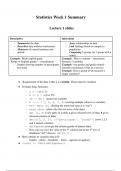Summary
Summary Statistics ALL weeks 1-7 summaries
- Module
- Institution
The file contains all summaries from the Statistics course from weeks 1-7. The information is taken from the lecture slides and the book. These summaries help studying for the exam.
[Show more]



